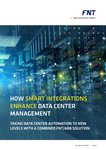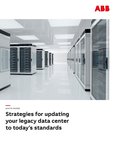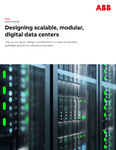“Work smarter, not harder,” goes the common cliché. But managing a facility as complex and essential as a data center requires both – a lack of smart features in the tools and technologies used to manage the facility, and it doesn’t matter how hard you work, success will be that much more challenging to achieve.
Of course, few solution providers will concede that their products and services aren’t really that smart. So, the question is, in a demanding sector and a fast-changing market, what really counts as ‘smart’, what new features should it provide, and what should data center professionals look for in a genuinely ‘smart partner’?
“Really smart solutions today provide deep component-level visibility. This means that you can monitor at the most granular possible level to improve the performance and efficiency of the entire electrical network,” says Narain Chandwani, sector manager – Data Centers, at industrial giant ABB.
Chandwani goes on to explain in more detail: “By visibility, what we mean is that the more you can monitor and analyze the data that you pick up, the more effectively that you can run a proactive maintenance strategy, saving time, money and resources.
“Then you have to ask, can you deep dive and, say, get actionable energy efficiency insights, such as where you are ‘losing’ power? That is to say, can you see where the power is being utilized, and where it is being wasted?”
This kind of visibility, adds Chandwani, is essential not just in terms of power management, but across the board throughout every area of the data center.
For example, in cooling, sensors can pick up temperature and humidity data, and identify hot spots, as well as water intake and consumption. From this data, valuable metrics such as the ratio of water usage to IT load can be worked out, not to mention PUE – power usage effectiveness.
“So then you can ask, do you have assets that are not running fully loaded? What is their level of utilization? That’s important whether it’s cooling, IT assets, anything,” says Chandwani, enabling all aspects of operation to be fine-tuned for maximum efficiency.
In this way, there should be barely any attribute of the data center, the resources it uses and the way it runs that is hidden from the people tasked with ensuring that it runs at optimal efficiency.
Switched on
But, says Chandwani, ABB goes further in technologies such as its digital switchgear, which can monitor their own operational health. Multiple built-in sensors constantly measure temperature and humidity, as well as the utilization and operating cycles of electrical devices, and as conditions change they can predict potential failures before they occur, or sound alerts for when proactive maintenance may be needed.
Digital switchgear loaded with sensors also improve safety, he adds, as well as accuracy. “For example, instead of using conventional CDs and VTs, you use sensors. It not only improves accuracy, but also safety. If you're using a current sensor instead of a current transformer – the conventional approach – then you eliminate the risk of open circuit, which can be catastrophic if you leave a circuit open,” says Chandwani.
“Also, sensors are much lighter in weight and can have multiple ratios. If you’re making changes to your power infrastructure you don’t have to replace the sensor because the range it can handle is so broad,” he adds.
Most of ABB’s low-voltage and medium-voltage switchgear are available in digital versions up to about 33 kilovolts, too, which can cut installation, testing and commissioning times, slash operational expenditure by up to one-third, and reduce unplanned downtime.
These sensors feed information to ABB’s Ability Data Center Automation platform where it can all be brought together, analyzed and acted upon, although ABB’s sensor technology is based upon open – not proprietary – industry standards, so there is no vendor lock-in.
Indeed, as a result, the platform can easily integrate solutions from multiple different vendors, enabling customers to buy their preferred best of breed equipment, and connect it all together and manage it as one.
Corporate communications
Holding ABB’s smart infrastructure products together is industry standard IEC 61850 peer-to-peer messaging, enabling ABB Ability Data Center Automation to orchestrate the entire ‘show’ – not just of ABB’s data center hardware, but any hardware from any vendor that also supports this standard.
“IEC 61850 is not only comprehensive, but you can have a combination of LV and MV installation that not only gives you device-to-device communication, but real-time diagnostics and integrated engineering,” says Chandwani.
Under IEC 61850, the sensors communicate over fiber using GOOSE [Generic Object Oriented Substation Event] messaging. This provides continuous monitoring, compared to the cyclical monitoring offered by other protocols.
The GOOSE protocols are an integral part of IEC 61850, which is increasingly being integrated in smart grids, making adoption of IEC 61850 and GOOSE a means of future-proofing data center infrastructure.
But it is ABB Ability Data Center Automation where all the information is brought together, helping data center staff to make sense of their increasing complex environments under one, scalable management system.
“The system operates in real time and it knows exactly where every kilowatt is going. It monitors everything. It's quite normal for a mid-size data center to have anywhere between 80,000 and 200,000 monitoring points. Some bigger data centers will be on 500,000 or beyond, which you can monitor in real time,” Madhav Kalia, global head of Data Center Automation at ABB, told DCD in a recent feature.
That combination of smart sensor technology and ABB Ability Data Center Automation can help break down the silos that have made the technical side of data center management so challenging.
Kalia continued: “Most of the time in data centers, they don't have the capability in their teams to do integration with various different subsystems, that normally goes to the vendors who supplied it. So one of the biggest challenges in the data center industry today is how to connect.
“The ABB Ability Data Center Automation solution is designed by default to connect to everything, but at the same time, not just connect to a specific type of equipment. All data in the same time series is collected right from the grid connection to the end of the rack, and everything is monitored at the same level,” says Kalia.
With the various elements of data center infrastructure unbound from their respective silos, ABB Ability Genix Industrial Analytics and AI Suite can be unleashed. This enables users to run models based on the data collected by the platform in order build optimization algorithms that can be implemented across the facility.
But the really smart feature is the ability of the platform to use the data generated by the sensors to learn how each and every part of the facility operates. Anomalies can be quickly identified and highlighted, and adjustments made accordingly.
Of course, if a sensor located anywhere in the facility ‘drops out’ for any reason, that is easily flagged and can be repaired or replaced. But it is the predictive maintenance that the information from the sensors enable, which can both radically cut costs and improve efficiency.
“For long-term maintenance, we do have smart maintenance solutions, giving you predictive maintenance. Instead of conducting maintenance at regular intervals, whether it’s needed or not, but with our predictive maintenance packages, we can monitor the health of the assets and only supply maintenance when it’s really needed,” says Chandwani.
Moreover, he adds, ABB can now provide assistance services remotely using augmented reality, helping customers to solve any technical issues on-site without the need for an expensive site visit.
Bleeding Edge
With the rise of Edge distributed data center architectures, the ability to remotely monitor and manage the infrastructure will become essential. Edge data center facilities could be located at mobile phone base stations, in hospitals and even at military facilities, and may also be modular and highly mobile.
“We did a colocation site in Australia where we supplied the transformer, MV switchgear and the LV switchgear on a skid. We supplied all the gear, and the skid was manufactured by somebody else. And then the gear was installed on the skids pre-tested completely before it went to the site, with the electrical equipment capable of being monitored remotely” says Chandwani..
“We also do what we call e-houses, that could be the size of a standard shipping container, for easy transportation, or they could be a custom-made portable building to suit the particular application. So we can put MV switch gear, transformer, UPS and LV switchgear – everything – all in one container or portable building.
“We also have what we call a standard compact secondary substation (CSS) that contains a pre-engineered standard solution with a transformer, medium voltage RMU and LV switchgear and we can do that for up to 3.5 MVA,” says Chandwani.
And all that can be protected with proactive smart monitoring, with ABB also looking to add extra intelligence to the remote monitoring with machine learning and artificial intelligence.
“We ran a pilot project with a colocation provider in Singapore where both machine learning and AI were used for cooling. The target was to save at least 10 percent in terms of cooling energy consumption,” says Chandwani. Cooling, of course, is the largest consumer of electrical power in the data center, after the IT equipment.
The project, with ST Telemedia Global Data Centres, is part of the 130-facility data center operator’s efforts to achieve carbon neutrality by 2030.
Conducted in two phases, the first involved data exploration, modelling and validation, studying historical data to establish how ABB’s digital solutions could improve existing operations and energy use. The second phase involved AI control logic testing in a live data center environment.
The next step is to roll-out lessons learned across the organization’s 130 facilities across the world, including Singapore, the UK, India, and South Korea.
No dramas
It used to be said that an advanced society would quickly turn to chaos if the power were to go down for any extended period of time – supply chains would break down causing supermarkets to be stripped bare, and the breakdown of law and order would follow shortly after. Today, the same may be true of data centers.
That’s why sophisticated sensor technology, communicating over industry standard protocols and supporting heterogenous environments is essential for both data centers and the electrical infrastructure that keeps them running. Data centers have fast become the pervasive backbone of the modern world and society, and nobody wants any dramas, large or small, as a result of any downtime.
To find out more about ABB’s smart solutions, go to ABB’s specialist Smart Solutions for Sustainable Data Centers website
More on ABB
-

Sponsored Getting in touch with (augmented) reality
Augmented reality is driving a revolution in the field of data center service
-

Sponsored Optimization via digitization
Why AI-based optimization models could be the answer to improved energy utilization in your data center
-

Energy crisis and supply chain disruption
How global events are reimagining servicing in 2023





